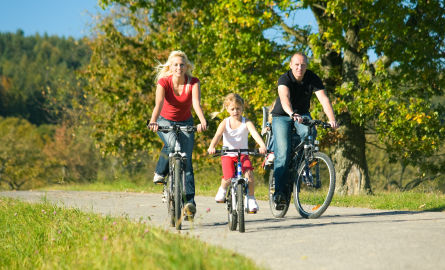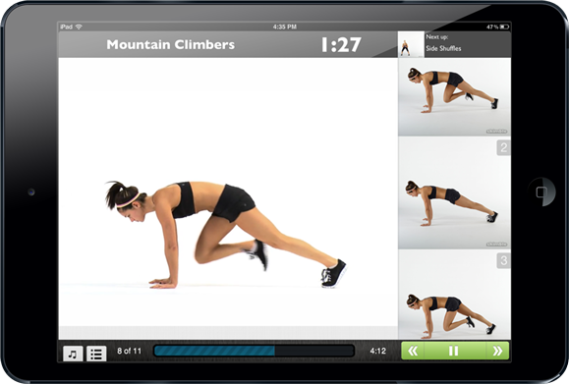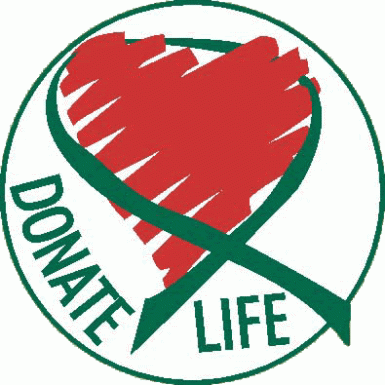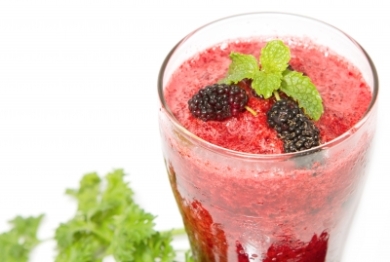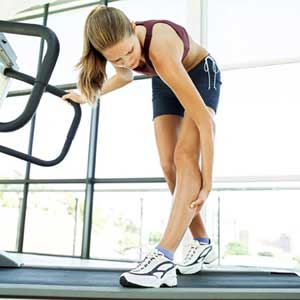Five Spring / Summer Activities to Get You Fit While Having Fun
Looking to mix up your boring fitness routine? Consider swapping your usual run or workout at the gym with one of the following outdoor summer activities that will make you break a sweat while still having fun.
Beach volleyball: If you’re headed to the beach, try starting a pickup game of volleyball, or consider joining a rec league team. A 155-pound person can burn up to 550 calories in 60 minutes!
Inline skating: For a fun way to burn 490 calories in an hour, dust off your old inline skates and take them for a spin. Be sure to wear all the necessary protective gear when you do.
Ultimate Frisbee: A combination of Frisbee and football, this game is a great way to sheds pounds with some friends. A 155- pound person can spend 240 calories in just an hour.
Tennis: If you want a great workout, grab a friend for a game of tennis. During an hour long match you’ll burn 560 calories.
Swimming: On those especially hot days, head to the nearest body of water and go for a swim. Doing laps for an hour will have you burning up to 560 calories!
For more information on life insurance, contact your agent.
Seasonal Allergies: Spring
Mold growth blooms inside and outside with spring rains. As flowers, trees, weeds and grasses begin to blossom, allergies will follow.
Spring-cleaning activities can stir up dust mites, so be sure to:
- Wash your bedding every week in hot water to help keep pollen under control.
- Wash your hair before going to bed, since pollen can accumulate in your hair.
- Wear a mask and gloves when cleaning, vacuuming or painting to limit dust and chemical inhalation and skin exposure.
- Vacuum twice a week.
- Limit the number of throw rugs in your home to reduce dust and mold.
- Make sure the rugs you do have are washable.
- Change air conditioning and heating air filters often.
For more information on preventing spring allergies from taking over, contact your doctor. For more information regarding your insurance, contact your agent.
High Blood Pressure
Each time the heart beats, it pumps out blood into the arteries. Blood pressure is highest when the heart beats (called systolic pressure) and lowest when at rest (diastolic pressure). This is why blood pressure is always given as two numbers, such as 120/80, which is considered the normal range. Once the level reaches 140/90 or above, it is considered high blood pressure. With this condition, the heart and arteries work harder, and the chances of a stroke, heart attack or kidney problems are greater.
Causes and Risk Factors
No single specific cause has been identified in people with high blood pressure, but research is ongoing. In some people, it is the result of another medical problem or medication. When the cause is known, this is called secondary high blood pressure. Research has shown that the following factors put one more at risk for high blood pressure:
- Obesity
- Being African-American
- If male, being over age 45; if female, being over age 55
- A family history
- Having prehypertension (blood pressure in the 120-139/80-89 range)
- Excessive salt and/or alcohol consumption
- Not enough potassium in the diet
- Being physically inactive
- Having ongoing stress
- Smoking
- If female, taking certain oral contraceptives
Symptoms
Those with high blood pressure may have it for years without knowing, due to its lack of symptoms. The only way to find out is to have routine blood pressure checks during every visit to the doctor.
The Importance of Treatment
The first and best course of action when high blood pressure is discovered is to change eating and exercise habits. However, sometimes even when a person makes healthy changes, blood pressure remains high. In that case, a physician will most likely prescribe a blood pressure medication. If left untreated, high blood pressure can cause:
- Enlarging of the heart, which leads to heart failure
- Aneurysms in the arteries of the heart, brain, legs, intestines or spleen
- Narrowing of the blood vessels in the kidney, leading to kidney failure
- Hardening of the arteries, which can cause a heart attack, stroke or kidney failure
- Blood vessels bursting in the eyes
Prevention
High blood pressure can easily be prevented. Some of the best ways to avoid the condition include:
- Limiting salt, fats and alcohol
- Eating healthy foods such as fruits, vegetables, whole grains and low-fat dairy products
- Maintaining a healthy weight
- Being physically active
- Quitting smoking
Did You Know..?
Those with high blood pressure often exhibit few or no symptoms, which is why the condition is frequently referred to as the “silent killer.” For more information on controlling blood pressure, contact your physician. For more information regarding life insurance, contact your agent.
Food Safety Tips for Grilling
Grilling season is around the corner! When planning your next outdoor menu, one item you’ll definitely want to leave off the plate is foodborne illness—here’s how:
- Wash everything – Before and after cooking, wash all indoor and outdoor surfaces that will come into contact with food. Be especially careful to wash everything that comes into contact with raw meat or poultry and wash your hands often to prevent contamination.
- Marinate safely – If you plan on marinating raw meat, do so in a covered container in a refrigerator, not on the counter. This decreases the risk of bacteria.
- Keep everything covered – Cover all food with tin foil while outside. This keeps insects or bacteria from landing on and contaminating your food.
- Keep hot foods hot – Grilled food that is finished cooking can be kept hot until serving by moving it to the side of the grill rack. This keeps the food from overcooking and prevents bacteria from forming.
For more information on food safety tips for your health or questions regarding your life insurance, contact your agent.
Outdoor Exercise
Ready to move your exercise routine outdoors? As the temperature climbs, so does your risk of suffering from a heat-related illness. Review the list below to stay safe as the mercury rises:
- Stay hydrated by drinking plenty of water the day before, the day of, and after your workout.
- Avoid exercising between 10 a.m. and 4 p.m., the hottest period of the day.
- Wear a hat and sunglasses to reduce exposure to the sun.
- Be aware of the symptoms of a heat-related illness and take immediate precautions if you begin to feel faint, dizzy, nauseated, are sweating heavily, or experiencing a weak or rapid heartbeat.
DID YOU KNOW
Without taking the necessary precautions, exercising in high temperatures can lead to:
- Heat cramps
- Heat exhaustion
- Heatstroke
For more information on exercise tips, contact your physician. For more information regarding life insurance, contact your agent.
Is Your Workout Tech-savvy?
While technology is not a mandatory addition to your workout, many individuals find it useful and even motivating. Music players are only the tip of the iceberg—whatever your fitness regime, there’s probably some sort of device or app for it.
If you’re looking to make your solo workout more exciting and interactive, fitness gaming, or active video games, might be for you. From yoga to boxing to tennis, there are many types of fitness video games that really do make you break a sweat.
For smartphone lovers, there are apps that can remind you it’s time to exercise, and track distance travelled, your course and workout time—some of these apps are even available to download for free.
Those numeric-minded individuals looking for measurable results may find pedometers, heart rate monitors and multi-purpose tools useful. From measuring sleep quality to tracking the number of calories burned, these tools record workout and daily activity levels.
If your workout routine hits a bump in the road, try giving it a technological twist—you may find it’s just what you need to boost motivation and get back on track.
For more information regarding online tools to help keep you active, contact your mobile phone provider. For more information regarding life insurance, contact your agent.
Organ Donation
More than 114,000 Americans are currently on the waiting list for an organ donation, but last year only 14,147 organs were donated.
There are two systems for organ donation: opt-in and opt-out. Most European countries operate on an opt-out system, which assumes that a person is willing to donate their organs, though individuals are free to opt-out.
The United States uses an opt-in system for organ donation, so people are required to designate in advance that they are willing to donate their organs. If a person is not a registered donor, that person’s organs cannot be given to people on the organ donor list.
A single organ donor can save up to eight lives, so consider registering as a donor at www.organdonor.gov.
DID YOU KNOW
More than 80 percent of people on the organ donation list are waiting for a kidney, but most children under the age of 5 on the list are waiting for a liver transplant.
For more information regarding organ donation and how you can get involved, contact your physician. For more information regarding your life insurance, contact your agent.
Eat Well, Live Well
Replacing unhealthy eating habits with healthier ones can be difficult, especially if unhealthy habits are all you’ve ever known. One key to making lasting improvements in your diet is to make changes in stages. Start with a small, simple change and stick to it for a week. After one change has been mastered, add another.
Some Ideas to Get You Started
- Eat breakfast.
- Replace one sugary drink per day with a glass of water.
- Eat one to two more fruits or vegetables each day.
- Plan a healthy snack for each day of the week.
- Switch to a low-fat version of one of your favorite foods.
- Plan three meals and two snacks every day.
- Plan as many home-cooked meals as you can, as they usually have fewer calories, more reasonable portions and cost less than typical meals eaten at restaurants.
Set an Example
Parents play a big role in guiding their children’s eating habits with the examples they set, the foods they make available in the home and the mealtime experiences that they create for their families.
Offer healthy snacks such as fruit, low-fat cottage cheese or yogurt, frozen juice bars, applesauce, celery, apples with peanut butter, raw vegetables, graham crackers, fig bars or whole wheat crackers with low-fat cheese. Large portions contain too many calories. A good-sized snack for a typical adult may be a single-serving container of yogurt, but for a preschooler, two or three tablespoons of yogurt is enough.
Make Eating an Enjoyable Activity for the Whole Family
Family meals can be a time to monitor what children are eating and to reconnect with each other. Involve children in food preparation and clean-up, and sit down with them when they eat. The idea is to build healthy lifelong eating habits.
Some healthy eating tips include the following:
- Eat plenty of fruit and vegetables—half your plate at each meal should be vegetables or fruit.
- Beware of sweetened drinks—sodas and sports drinks are high in calories. Keep in mind that the calories in juice can also quickly add up.
- Choose food sensibly when eating out. Restaurants are often required to make nutrition information readily available—if you don’t see brochures sitting out, or nutrition information listed on the menu, ask.
Healthy Food Tips When Eating Out
- Ask if you don’t know what is in a dish or the serving size.
- Eat the same portion size you would at home.
- Ask for sauces, gravy and dressings on the side—or avoid them altogether.
- Order foods that are not breaded or fried.
- Order fruit for dessert.
- Ask for substitutions, such as a vegetable instead of fries.
- Ask for low-calorie versions of food. Vinegar and oil or a squeeze of lemon are both better than high-fat dressings or sauces.
Did You Know…?
Substituting chips and candy bars with snack-sized portions of veggies will cut down on the calories and cholesterol in your diet. Not only are most vegetables low in calories and fat, but they are all cholesterol-free.
For more information on diets to keep you living healthy, contact your physician. For more information regarding life insurance, contact your agent.
Avoiding Common Workout Injuries
Diving headfirst into an intense exercise routine can be dangerous. Take care to ensure you’re putting safety first in every workout. Here are some common exercise-induced injuries and ways to avoid them:
- Knee pain – This can be caused by not warming up first when running on a treadmill. Generally the pain comes from the hips and can be avoided by doing some simple warm-up exercises, such as a plank, or keeping your back and waist straight and bending forward at the hip. Knee pain can also result from bike seats being too far forward, which is common in spinning classes.
- Shin splints – Stretching or walking to warm up before running will help you avoid the ache of shin splints. Shin splints come from imbalanced calves (i.e., the shin is less developed than the muscle), and should become less frequent with regular exercise.
- Sprains and strains – Rolling an ankle or extending a joint too far can end painfully. Strengthen your joints before starting workouts that require quick movements and great flexibility. Flexing your joints away from you while using exercise bands can really help to strengthen joint muscles.
For more information on workout tips, contact your physician. For more information regarding your insurance, contact your agent.






